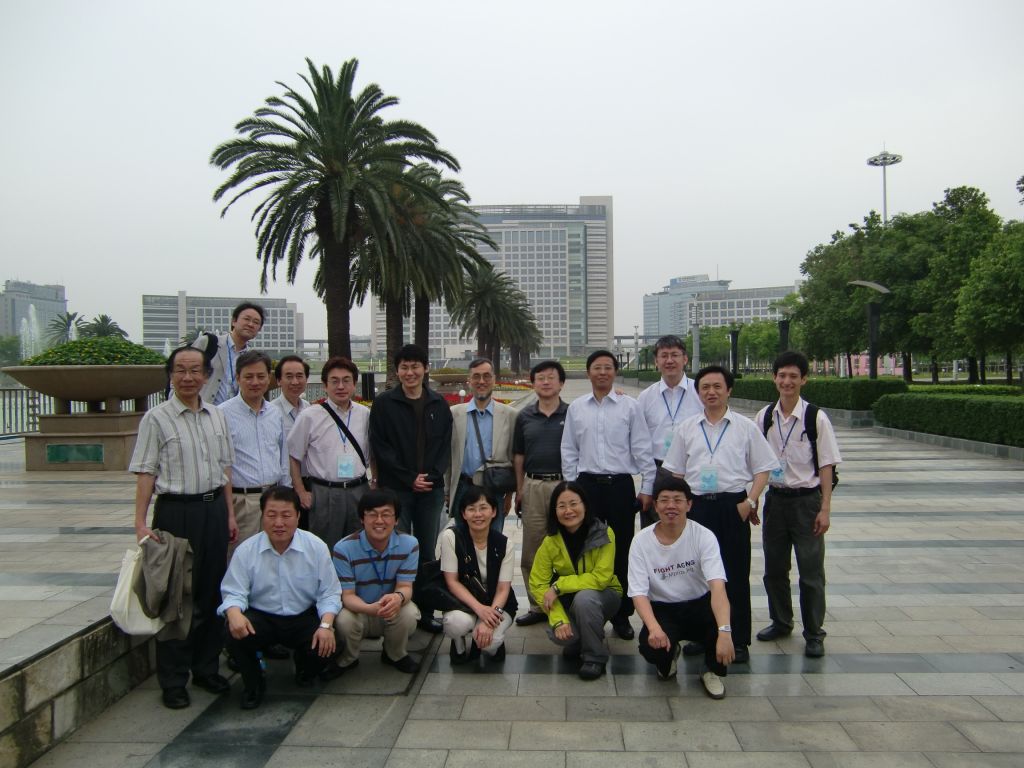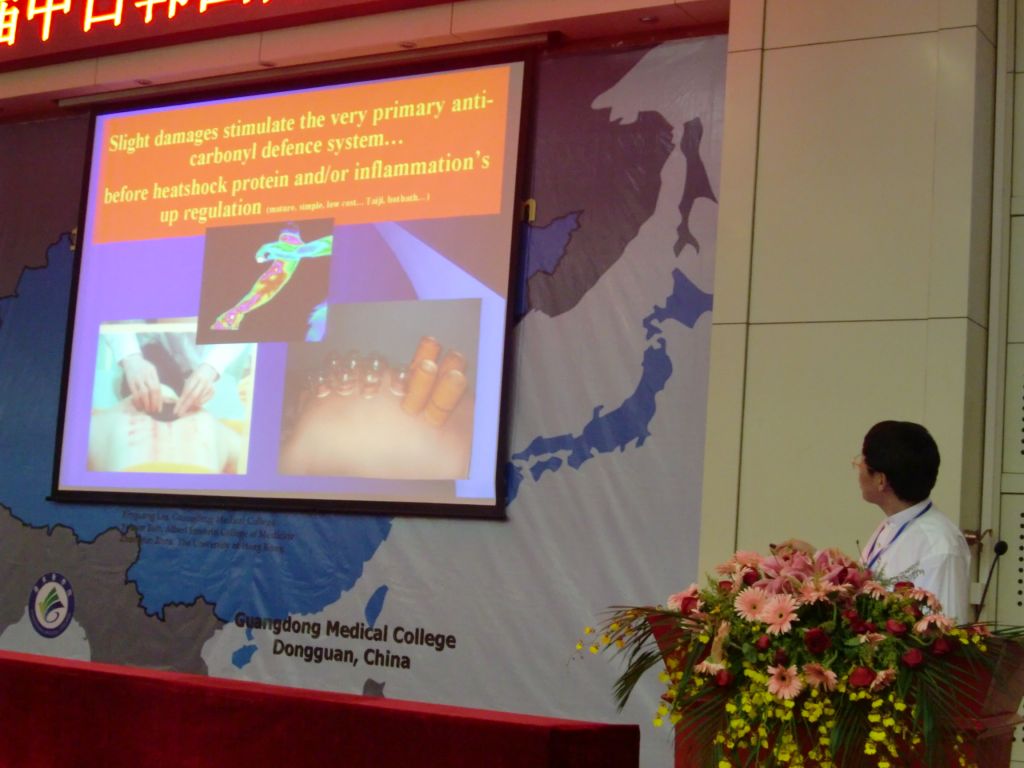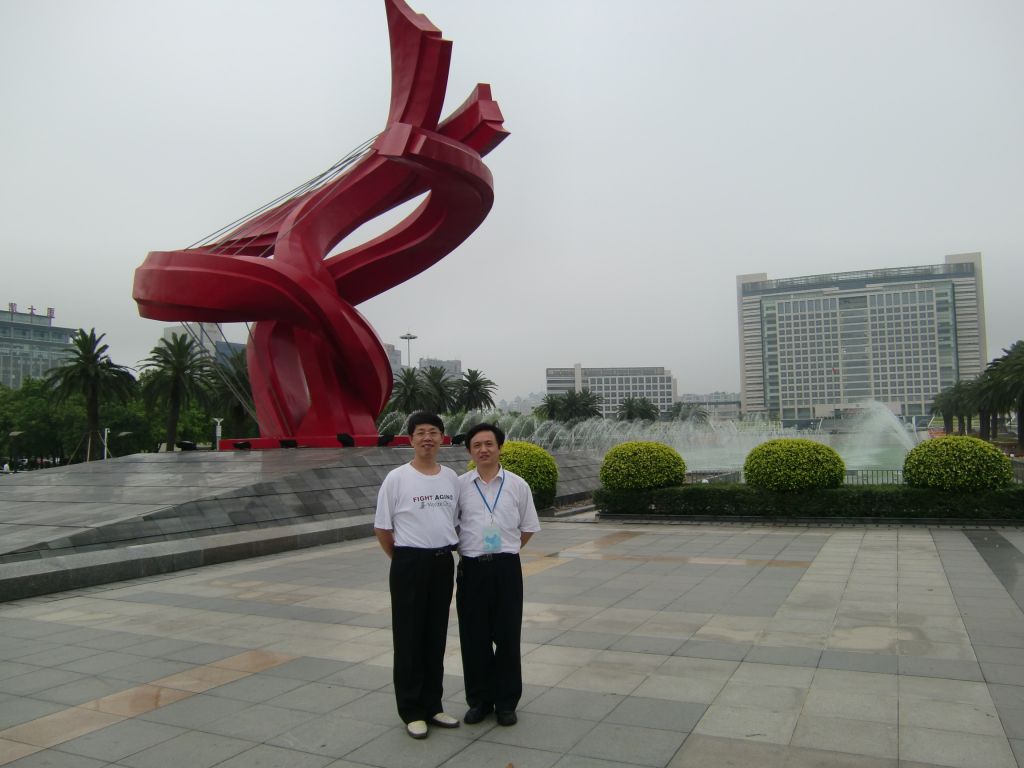博文
抗衰老三国会议简报
||
Introduction
Aging is an international problem. Nearly every developed country in the world is experiencing a demographic shift toward a more elderly population. This shift is particularly pronounced in some Asian countries. For example, it is expected that by 2050, more than one third of the Japanese population will be over the age of 65. This compares with a value of only 5% age 65 and over 50 years ago [1]. Similar trends can be observed in Korea and China, as well as other countries in Asia and worldwide. The consequences of this “graying of the population” are yet to be fully appreciated; however, it is clear that there will be significant impacts on society. For instance, there will not be enough people of working age to adequately pay for the high healthcare costs of a large number of elders. In addition, the sheer effort required to care for elderly family members will place substantial financial and emotional strain on younger individuals.
Scientific progress in understanding the basic mechanisms of aging offers an opportunity to lessen the negative impact of this demographic shift through the development of interventions to delay the onset and slow the progression of many age-related diseases. Such progress is the stated goal of the Trinations Aging Symposium and the presentations offer encouragement that this goal is attainable.
The Trinations Aging Symposium was attended by more than one hundred scientists and students from institutions located in Japan, Korea, China, and the United States.  Over a two day period, twenty-two speakers gave a series of stimulating presentations on a variety of topics related to the basic mechanisms of aging. Meeting sessions included “Metabolism and Aging”, “Longevity Promoting Agents and Aging Diseases”, and “Genome Integrity and Aging”.
Over a two day period, twenty-two speakers gave a series of stimulating presentations on a variety of topics related to the basic mechanisms of aging. Meeting sessions included “Metabolism and Aging”, “Longevity Promoting Agents and Aging Diseases”, and “Genome Integrity and Aging”.
Aging-related genes and pathways
The use of model organisms such as yeast, nematodes, flies, and rodents has provided a wealth of data regarding genes and interventions that influence aging. Perhaps the best studied of these is dietary restriction (DR, also referred to as caloric or calorie restriction), which can be defined as a reduction in nutrient availability in the absence of malnutrition. DR has been shown to extend life span in a variety of different species including yeast, nematodes, fruit flies, mice, rats, and rhesus monkeys [2,3,4]. Several factors have been proposed to be important in mediating the beneficial health and longevity effects of DR on a cellular level. These include the target of rapamycin (TOR) kinase, the sirtuin family of NAD-dependent protein deacetylases, and the growth hormone/insulin-like growth factor 1 (IGF-1) axis.
I. Shimokawa (Nagasaki University, Japan) suggested a key role for neuroendocrine signaling through neuropeptide-Y in life span extension from DR. His “neuroendocrine hypothesis of aging” posits that DR acts through hypothalamic and pituitary hormones to reduce reproduction and growth, enhancing longevity-promoting metabolic changes and stress responses [5]. Dr. Shimokawa described new studies in his lab examining the effect of DR on metabolic phenotypes and longevity in neuropeptide Y knockout mice.
H Yamashita (Chubu University, Japan) and N. Mori (Nagasaki University, Japan) also both presented studies of mouse models that link metabolic function and aging. Dr. Yamashita described his studies of mice lacking the uncoupling protein Ucp1 and the metabolic phenotypes of Ucp1-/- ApoE-/- double knock-out mice. Ucp1 is a mitochondrial transmembrane protein found in brown adipose tissue. Prior work had demonstrated that Ucp1-/- mice are hypersensitive to cold and diet induced obesity [6]. Dr. Mori presented new studies of longevity and health in mice lacking a neuron-specific isoform of ShcC, which his group had previously identified [7,8]. Mice lacking the non-neuronal p66Shc isoform are reported to be both long-lived [9] and resistant to diet induced obesity [10], but longevity data has not yet been reported for knockout of neuronal ShcC.
FOXO transcription factors are of particular interest, as several studies have indicated that variants of Foxo3a are associated with human longevity [11,12,13,14]. J. Lee (Hallym University, South Korea) discussed the importance of Foxo3a in promoting genome integrity during aging. He suggested that declining Foxo3a with age contributes to reduced DNA repair capacity, enhanced mutagenesis, and genomic instability. Although the functional significance of longevity-associated alleles of Foxo3a remains unknown, an interesting possibility is that these variants may result in increased expression and activity of DNA repair enzymes.
The theme of genetic variation in genome maintenance and aging continued with the presentation by Y. Suh (Albert Einstein College of Medicine, USA and Guangdong Medical College, China). Dr. Suh reported the identification of functional sequence variants in the human SIRT1 promoter that are associated with risk to myocardial infarction in Mexican Americans. These variants have led to the discovery of a novel pathway by which genotoxic stress leads to activation of SIRT1 gene expression, a mechanism that is abrogated in the risk carriers. This suggests that regulation of SIRT1 gene expression in response to genotoxic stress, to which all individuals are constantly exposed, is a component of the resilience program that protects against age-related disease, including myocardial infarction.
Invertebrate model organisms were well represented at the meeting, with speakers describing new insights from studies in the budding yeast Saccharomyces cerevisiae and the nematode Caenorhabditis elegans. W. Dang (Institute of Biochemistry and Cell Biology, China) presented evidence that the methyltransferase Hpa2 functions as a novel determinant of yeast replicative life span. Replicative life span is defined by the number of daughter cells a mother cell can produce before senescence [15]. Prior studies have indicated a key role for the Sir2 histone deacetylase in promoting replicative life span [16,17], and have shown that Sir2 protein levels decline with age, resulting in age-associated changes in histone acetylation [18]. Given that Sir2 and Hpa2 both influence chromatin structure through post-translational modification of histones, it is tempting to speculate that they may be influencing longevity through similar downstream mechanisms. B. Kennedy (Buck Institute for Research on Aging, USA and Guangdong Medical College, China) also presented data from studies of replicative aging in yeast that implicate proteasomal function as a key determinant of longevity.
Two speakers presented data elucidating the importance of the hypoxic response for aging in Caenorhabditis elegans. M. Kaeberlein (University of Washington, USA and Guangdong Medical College, China) described published studies from his group and others that demonstrated that stabilization of the hypoxia inducible factor, HIF-1, is sufficient to extend life span in C. elegans [19]. Life span extension from stabilization of HIF-1 acts via a mechanism that is genetically distinct from both insulin-like signaling and dietary restriction [20,21,22]. He also described how deletion of hif-1 can increase life span in a temperature-dependent manner [23,24,25], and reported on new studies examining the downstream targets of HIF-1 involved in longevity control, as well as the tissues most important for HIF-1-mediated effects on longevity. S. Lee (Pohang University of Science and Technology, South Korea) then described his work showing that reactive oxygen species generated from mitochondria can induce HIF-1 to extend life span [26]. It has been known for some time that RNAi knock-down or mutation of certain mitochondrial genes can increase life span in C. elegans [27]; however, the mechanism has yet to be fully elucidated, and Dr. Lee’s studies offer intriguing new insight.
Studies of mechanisms leading to cellular senescence were also presented at the meeting. Telomere shortening is believed to contribute to cellular senescence in vivo [28], and I. Chung (Yonsei University, South Korea) described new data on regulation of telomerase, the primary enzyme responsible for elongating telomeres. He described studies of two telomerase-associated proteins: Mkrn1, a ubiquitin ligase that targets cytoplasmic human telomerase reverse transcriptase (hTERT) for proteasomal degradation and Ddx39, DEAD box RNA helicase that interacts with both hTERT and another telomere associated protein Trf2. M. Maruyama (National Center for Geriatrics and Gerontology, Japan) reported studies of Zizimin 2, a guanine nucleotide exchange factor expressed predominantly in lymphocytes [29] that he believes plays a role in immune senescence, and N. Mori described a novel neuronal cell culture model his lab has developed which may prove useful for understanding molecular processes associated with neuronal aging and senescence.
Three speakers at the Trinations Aging Symposium discussed large-scale, systems biology approaches to understand aging. L. Li (Chinese Academy of Sciences, China) reported microarray gene expression analysis during chronological aging in yeast that indicate a key role for carbon metabolism and glycerol accumulation in life span determination [30,31]. J. Han (Chinese Academy of Sciences, China) described her re-analysis of published brain microarray gene expression data sets taken from people of different ages [32]. This effort allowed her to define modules in the human brain aging network and to identify previously unknown links between gene functional groups important for aging [33]. Interestingly, genes that are known to modulate longevity are enriched at the interface of these modules. P. Khaitovich (Chinese Academy of Sciences, China) described his efforts to understand how the brain changes during aging using a comparative analysis of age-related gene-expression and proteomic changes in rhesus macaques and people.
Interventions to promote longevity and treat age-related disease
Our understanding of the pathways that modulate aging has reached the point where many scientists are confident that therapies designed to target these pathways will provide effective treatments for a variety of age-related diseases and, perhaps even slow the aging process itself. Two examples of this that were discussed at the meeting are resveratrol and rapamycin, compounds which have been shown to promote health and longevity in model organisms and are being actively studied as treatments for age-related diseases in people [34].
B. Kennedy presented data on the effects of rapamycin in mice lacking lamin A (Lmna-/-) as well as Zmpste24-/- mice that accumulate an aberrant form of LMNA associated with the human progeroid syndrome Hutchinson Guilford Progeria Syndrome (HGPS) [35]. In addition to HGPS, mutations in the LMNA gene cause a variety of different disorders, including muscular dystrophy, lipodystrophy, and cardiomyopathy [36]. Rapamycin is a small molecule inhibitor of the TOR kinase. Genetic or pharmacological inhibition of TOR signaling is effective at slowing aging in yeast, nematodes, and flies [37], and supplementation with rapamycin has been shown to increase life span in mice [38,39]. Based on his results to date, Dr. Kennedy speculated that rapamycin might be an effective treatment for at least a subset of LMNA-associated diseases.
B. Liu (University of Hong Kong and Guangdong Medical College) also presented data from collaborative studies with Dr. Z. Zhou (University of Hong Kong) of Zmpte24-/- mice treated with resveratrol. Resveratrol is a polyphenolic compound that has been shown to enhance survival of mice fed a high-fat diet and delay the onset of several age-related phenotypes [34]. The mechanism by which resveratrol influences aging-related processes remains controversial, and both AMP kinase and SIRT1 have been proposed as important molecular targets [40]. Dr. Liu discussed the importance of SIRT1 in stem cells and speculated that at least some of the premature aging phenotypes of these mice may arise from altered SIRT1 function. E. Hwang (University of Seoul, South Korea) presented additional data on the importance of SIRT1 during cellular senescence and reported dramatic effects of nicotinamide on mitochondrial function and morphology. He speculated that nicotinamide could modulate SIRT1 activity and mitochondrial function during cellular aging by altering the NAD+/NADH ratio. SIRT1 is an NAD-dependent protein deacetylase that is activated by NAD+ and inhibited by NADH [41,42,43].
Several speakers discussed the potential beneficial effects of traditional therapies for health and longevity. D. Yin (Hunan Normal University, China) speculated that some traditional therapies may protect against age-related disease by inducing a hormetic response. In the context of aging, hormesis refers to the idea that a small amount of damage or stress can actually slow aging by inducing stress response and damage repair pathways that are important for maintaining homeostasis [44]. T. Tabira (Juntendo University, Japan) reported positive effects associated with Juzen-Taiho to, an herbal mix used to enhance immune function, in an Alzheimer’s disease model. He also described exciting data on an Alzheimer’s disease vaccine that is effective at clearing amyloid in both mice and monkeys. H. Ozawa (Nagasaki University, Japan) described the importance of avoiding depression for Alzheimer’s disease patients, emphasizing that those with depressive disorders are more likely to suffer a more rapid decline during Alzheimer’s disease progression. He showed striking pictures and video footage taken soon after the 9.0 magnitude earthquake that struck Japan on March 11, 2011. He speculated that depression and post-traumatic stress associated with disasters such as the earthquake may contribute to high rates of dementia in the elderly and that antidepressants may prove useful for alleviating this concern.
Y. Honda (Tokyo Metropolitan Institute of Gerontology, Japan) and J. Lee (Seoul National University, South Korea) presented data on two compounds that have recently been reported to extend life span in C. elegans. Dr. Honda described the beneficial effects of trehalose on longevity and healthspan and proposed that trehalose-6-phosphate synthase may be a key DAF-16 target that is important for longevity in response to reduced insulin-like signaling [45]. Dr. Lee reported life span extension by DDS, 4,4′-diaminodiphenylsulfone, which is the most common drug prescribed to treat Hansen disease patients [46]. He described how these studies were spurred by evidence from the work of Dr. Sang Chul Park and colleagues that Hansen’s patients in South Korea who receive DDS live longer than the general public. In addition to its antibacterial activity, DDS enhances oxidative stress resistance in C. elegans and mammalian cells [46]. Dr. Lee presented evidence that pyruvate kinase is a protein target of DDS and reported that a mutation in this enzyme also conferred extended lifespan in C. elegans.
Conclusion
The First Trination’s Aging Symposium was a great success. The meeting ended with an agreement that similar symposia should be held annually and be expanded to include scientists from the entire Asian region. A committee consisting of Z. Zhou, E. Hwang, and I. Shimokawa was formed to begin planning for the 2012 symposium, as well as the formation of a new organization, the Asian Association for Aging Research (AAAR), to promote aging-related research in Asia. The birth of the AAAR at this Symposium may prove to be the most important outcome of the meeting and will hopefully positively influence scientific progress in understanding basic mechanisms of aging in Asia and around the world.
Asia needs to emphasize aging research, as it is a the center of the impending “silver tsunami.” Those who decide research funding in Asian countries should devote significant resources to understanding the basic mechanisms of aging and developing therapies that target the aging process itself. This is the future of medicine. There is no question that aging drives nearly every major cause of mortality in developed nations and, for the first time, we now understand many of the pathways that modulate the aging process. Interventions that target these pathways are showing promising effects against a broad spectrum of aging-related pathologies in pre-clinical and clinical models. No other area of biomedical science holds as much potential to improve quality of life for as many individuals, as well as improving the economic outlook for nations increasingly struggling with the high cost of caring for the elderly.
The biology of aging is amazingly complex. We believe that cooperation is the key to future breakthrough. The open exchange of ideas that accompanied the Trinations Aging symposium is thus a beacon of future success in Asian aging-related research, and a major goal of the AAAR will be to foster this spirit. The best evidence for this spirit of cooperation came from the last event of the symposium, a bus trip to Hong Kong. When the bus would not start, scientists from four countries demonstrated their collective brawn by pushing the bus forward, achieving a speed sufficient for the driver to ignite the engine. We expect more scientists in Asia to get on the aging research bus and that problems with ignition will be a thing of the past in the push to develop therapeutic approaches to extend human healthspan.
中医抗衰老策略的科学解读

东莞市中心的亚洲最大的广场
https://blog.sciencenet.cn/blog-38405-442296.html
上一篇:向科学网真诚道歉
下一篇:如何证明中药的无毒与有效